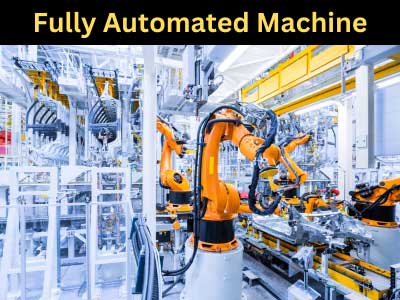Key Takeaway
Yes, manufacturing can be fully automated, a process known as lights-out manufacturing. In this system, machines manage everything, from assembly to quality control, while human involvement is limited to setup and maintenance. Full automation offers several benefits, such as reduced production costs, increased efficiency, and improved product quality. It also creates a safer workplace by eliminating the need for humans to perform repetitive or hazardous tasks. Technologies like AI, robotics, and machine learning play critical roles in achieving full automation. However, this requires significant investment and advanced technology to implement.
Current State of Automation in Manufacturing
Automation in manufacturing is already well established in certain industries, particularly in automotive, electronics, and consumer goods. In these sectors, robots and machines handle repetitive tasks like welding, assembly, and inspection. For example, in automotive plants, robots are used for assembling vehicles with incredible precision and speed. These robots excel at tasks that involve repetition and accuracy, which humans may find difficult to maintain over long periods. However, most manufacturing plants still rely on a hybrid model that blends human oversight with automation. Humans are responsible for decision-making, problem-solving, and overseeing the production process. Even in highly automated industries, the human touch is often required for tasks that involve creativity, adaptability, or complex troubleshooting. So, while automation has advanced, it is far from being fully implemented across the board. The current state of automation is more about enhancing human capabilities rather than replacing them entirely.

The Benefits of Full Automation
The benefits of fully automating manufacturing are clear and compelling. One of the most significant advantages is increased productivity. Machines and robots can work 24/7 without breaks, allowing businesses to scale up production significantly. This non-stop operation can drastically increase output while reducing production time. Another major benefit is the reduction of human error. Machines are programmed for precision, ensuring consistent quality and reducing defects. This can lead to significant cost savings in terms of rework, scrap, and downtime. Full automation also lowers labor costs since fewer workers are needed to manage production lines. Instead, highly skilled workers focus on maintenance, programming, and optimization of the automated systems. Furthermore, fully automated systems can offer scalability, enabling manufacturers to ramp up production without a corresponding increase in labor costs. Overall, the benefits of full automation can drive efficiency, quality, and profitability to new heights for manufacturers.
Challenges and Limitations of Full Automation
Despite the many advantages of full automation, several challenges and limitations remain. One of the biggest obstacles is the high upfront cost of implementing an automated system. Purchasing robots, AI systems, and the accompanying infrastructure is a significant investment that many small and medium-sized manufacturers cannot afford. Beyond the financial aspect, there is the challenge of adapting to the complexity of certain tasks. While machines excel at repetitive tasks, they struggle with operations that require human intuition, creativity, and problem-solving. For example, product customization or changes in production lines may require human intervention. Another issue is the potential loss of jobs due to automation. While automation may reduce labor costs, it could also lead to unemployment in industries where manual labor has traditionally been the backbone. Additionally, fully automated systems are vulnerable to cybersecurity risks. As manufacturing systems become more connected, they are more susceptible to cyberattacks, which could disrupt production or compromise sensitive data.
Technological Advances Driving Full Automation
Technological advances are continuously driving the push towards full automation in manufacturing. Artificial intelligence (AI) plays a crucial role in enabling machines to learn from data, adapt to changes, and make decisions in real time. With AI, machines can become more efficient, predict failures before they happen, and adjust production processes based on demand. The Internet of Things (IoT) is another significant advancement. IoT enables devices to communicate with each other, creating a network of connected machines that share data and optimize performance. In modern manufacturing plants, IoT sensors are used to monitor machine health, predict maintenance needs, and improve efficiency across the production line. Robotics technology has also made significant strides, with robots now able to perform tasks that were once considered too delicate or complex for machines. These technological advancements are making full automation a more realistic goal, but widespread adoption will still take time, especially in industries that require a high degree of customization and flexibility.
Future Possibilities for Fully Automated Manufacturing
The future of fully automated manufacturing holds exciting possibilities. Smart factories, driven by AI and IoT, could operate autonomously, with minimal human intervention. In these smart factories, machines would not only perform production tasks but also monitor and optimize themselves in real time. For example, if a machine detects that it’s starting to malfunction, it could order its own maintenance, preventing downtime and ensuring continuous production. Furthermore, fully automated factories would be able to adapt instantly to changes in demand, shifting production lines to accommodate new products or market needs without human input. However, while these possibilities are exciting, there are still hurdles to overcome. The infrastructure required for full automation is expensive, and the technological gap between industries means that some sectors will adopt automation faster than others. Nevertheless, as technology continues to evolve, fully automated manufacturing is becoming less of a distant dream and more of a tangible reality for the future.
Conclusion
Fully automating manufacturing offers a promising future, but it’s not without its challenges. The benefits, such as increased productivity, reduced labor costs, and improved product quality, are clear. However, high implementation costs, the complexity of certain tasks, and potential cybersecurity risks remain significant barriers. Technological advancements in AI, robotics, and IoT are pushing us closer to full automation, and the future looks bright for industries that can afford to invest in these systems. While we’re not quite there yet, the day when manufacturing can be fully automated is on the horizon. The key will be balancing the efficiency of machines with the unique capabilities of human workers to create a manufacturing environment that is both highly productive and adaptable.
